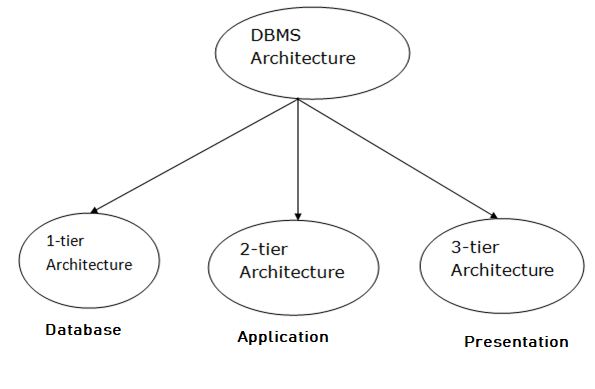DBMS Concepts And Architecture Introduction in Hindi
DBMS Concepts And Architecture Introduction in Hindi
DBMS का Design उसके Architecture पर निर्भर करता है। इसे centralized या decentralized या hierarchical किया जा सकता है। DBMS के Architecture को single tier या multi-tier के रूप में देखा जा सकता है। n-tier Architecture पूरे System से related लेकिन independent n modules, में विभाजित करता है, जिसे independently altered, modified, changed किया जा सकता है
1-tier architecture में, DBMS एकमात्र unit है जहां user सीधे DBMS का उपयोग कर सकता है । यहां किए गए कोई भी परिवर्तन सीधे DBMS पर ही किए जाएंगे। यह end user के लिए उपयोगी tool उपलब्ध नहीं कराता है। दाताबसे Designer और programmers आम तौर पर Single -tier architecture का उपयोग करना पसंद करते हैं।
अगर DBMS का Architecture 2-tier है, तो उसके पास एक Application होना चाहिए, जिसके माध्यम से DBMS को Access किया जा सके। programmers 2-tier Architecture का उपयोग करते हैं जहां वे एक Application के माध्यम से DBMS तक पहुंचते हैं। यहां operation , Design और Programming की terms में Application tier database से पूरी तरह से independent है।
3-tier Architecture
3-tier Architecture users की complexity के आधार पर अपने tiers को एक-दूसरे से अलग करती है और वे database में मौजूद data का use करते हैं। यह एक DBMS design करने के लिए सबसे widely used Architecture है।

Database (Data) Tier :
इस tiers पर, database अपनी query processing languages के साथ रहता है। जो इस tier पर data और उनकी constraints को परिभाषित करते हैं।
Application (Middle) Tier :
इस tier पर database को Access करने वाले Application Server और Programs होते है। एक user के लिए, यह Application tier database का abstracted view presents करता है।
User (Presentation) Tier :
end-user इस tier पर काम करते हैं और उन्हें इस layer से परे database के किसी भी existence के बारे में कुछ नहीं पता है। इस Tier पर, Database के कई view Application द्वारा प्रदान किए जा सकते हैं। सभी views Application tier में रहने वाले Application द्वारा generate किए जाते हैं।
Related Post
- DBMS And RDBMS concepts in Hindi (Database Management System in Hindi)
- DBMS Concepts And Architecture Introduction in Hindi
- Database Approach v/s Traditional File Accessing Approach in Hindi
- Advantages of Database Management System in Hindi
- Data Models in DBMS in Hindi
- Instance and Schema in DBMS in Hindi
- Database Languages and Interfaces in DBMS in hindi
- Functions of Database Administrator (DBA) in DBMS in Hindi
- Generalization, Specialization and Aggregation in ER Model in Hindi
- Converting ER Diagram to tables in DBMS in Hindi | Reduction of ER diagram to Table in Hindi
- Characteristics of Database Management System | Characteristics of DBMS in Hindi
- Types of Databases in Hindi
- Three Schema Architecture of DBMS in Hindi